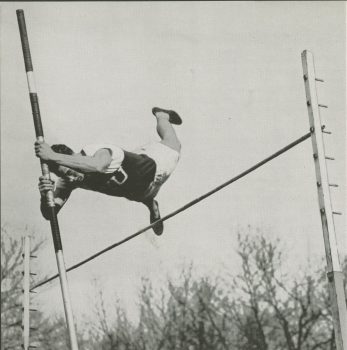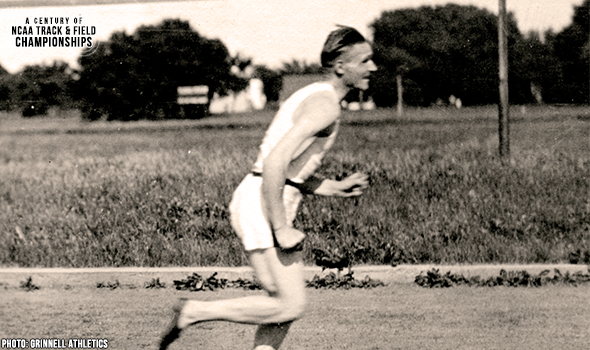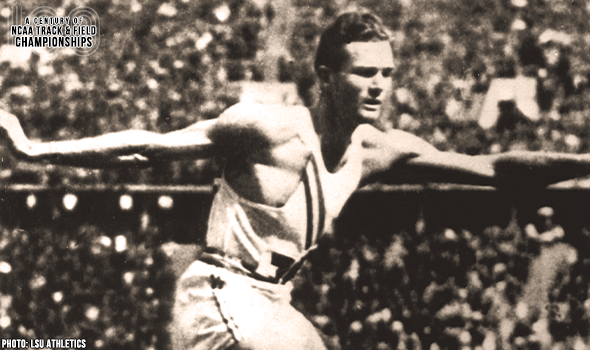
“Moon” Rose To Occasion In High Jump
By the time Irving Mondschein returned to NYU from Army service during World War II, it’s likely few could believe their eyes.
Mondschein had left in 1943 as a 19-year-old with a 5-foot-9, 160-pound build but when he returned in 1946, he stood 6-foot-2 and weighed 200 pounds.
Not only that, but Mondschein – who gained the nickname “Moon” because his last name means “moonlight” in German – had won two AAU national titles.

Irv “Moon” Mondschein, shown here competing in the pole vault, was an accomplished decathlete as well. He won three AAU national titles (Photo: NYU Special Collections)
If there was a problem with any of this, it’s that his titles came in the decathlon, an event that wouldn’t be part of the NCAA Track & Field Championships until 1970. And his popularity on campus as a great athlete led him to starting positions on Violets’ football and basketball teams.
Mondschein made his debut at the NCAA Track & Field Championships in 1947, winning the high jump at 6-6¾ (2.00m) and placing fourth in the long jump with a PR 23-11¾ (7.31m).
Later that summer he won a third AAU decathlon title.
Mondschein tied for first in the 1948 NCAA high jump at 6-7 (2.01m), then later made the Olympic team in the decathlon, taking eighth in the London Games.
In 1949, Moon was second in the NCAA high jump, losing to Brown’s Dick Phillips, who jumped 6-7 to Moon’s 6-6 (1.98m). Three weeks earlier, Moon and Phillips tied for the IC4A title at 6-7⅞ (2.02m) – an NYU outdoor school record for Moon that remains until this day (It was tied in 2017).
That was the end of Moon’s competitive days as an athlete. Even before graduating, he took a coaching job at Lincoln University in Pennsylvania, leading the track & field, basketball and football teams in a long mentoring career that saw him with several track & field stops – the longest at Penn (1965-87, the last eight as head coach) – before entering the USTFCCCA Coaches Hall of Fame in 2007.
Moon’s son, Brian, also competed in the NCAA meet (taking seventh in the 1977 decathlon for Washington), as did his grandson, also named Brian, who finished second and fourth for Virginia Tech in the 2005 and 2006 pole vault.
The NCAA and collegiate track & field will mark a momentous milestone in the spring of 2021 -- the 100th anniversary of the NCAA Championships and with that, the NCAA Track & Field Championships. In June 1921, the University of Chicago hosted the first track & field championships in NCAA history.
This point can’t be emphasized enough: Not only was the event the first for NCAA track & field, but the first championships for any sport under the sponsorship of the NCAA.
To celebrate, over each of the next 365 days, the U.S. Track & Field and Cross Country Coaches Association (USTFCCCA) will celebrate moments, student-athletes, and coaches that have made a century’s worth of championships special. From humble beginnings to important historical milestones to the modern-day, collegiate track & field has evolved with the American society.
The 2021 edition of the NCAA Division I Outdoor Track & Field Championships begin with preliminary round action on May 27-29 in Jacksonville, Fla., and College Station, Texas. The championships final site and culmination of the celebration is slated for June 9-12, 2021 at the newly rebuilt Hayward Field in Eugene, Ore.

SIU’s Roggy Dominated The Javelin In 1978
Bob Roggy won the javelin title at the 1978 NCAA DI Outdoor T&F Championships by more than 20 feet. Roggy qualified first for the final with a MR heave of 89.30m (293‑0).

Makusha Made History In Bowerman Year Of 2011
Ngoni Makusha became just the fourth man in meet history to win individual titles in both the 100 and LJ. It was his 3rd career LJ crown and he set a CR in the 100 of 9.89.

George Mason’s Gage Shocked The NCAA LJ In 1988
Nena Gage won the long jump at the 1988 NCAA DI Outdoor T&F Championships in a shocking upset over Gail Devers.

Texas’ Thompson Marveled In NCAA Distance Events
Jerry Thompson won three career distance titles at the NCAA Outdoor T&F Championships. His first came in 1943. Then he won again in 1947 & 1948 after serving in World War II.

Grinnell’s Paulu Sprinted To NCAA History
Leonard Paulu was the first athlete to complete the 100-200 double in NCAA Outdoor Track & Field Championships history in 1922. That also made him the 1st to win back-to-back 100 titles, too.

Scott Won Back-To-Back NCAA Hammer Titles
Candice Scott won back-to-back hammer throw titles at the NCAA DI Outdoor T&F Championships in 2003 & 2004. Scott set a meet record of 69.77m (228-11) in that first year.

Drouin Soared To The Bowerman In 2013
Derek Drouin won two career HJ titles at the NCAA DI Outdoor T&F Championships. When Drouin won in 2013, he was only the fourth man to clear 2.34m (7-8) in meet history.

Watts Made Quick Work Of NCAA 400
Quincy Watts set a meet record in the 400 of 44.00 at the 1992 NCAA DI Outdoor Track & Field Championships. It lasted 25 years until 2017.

Iowa State’s Koll Rolled To 5K-10K Crowns
Lisa Koll won three career titles at the NCAA DI Outdoor T&F Championships in dominant fashion. Her average margin of victory in those 5K & 10K races was 37.73 seconds.

LSU’s Hardin Completed Unique 440-220H Double Twice
The nearly unheard of 440-220H double was so nice that Glenn Hardin did it twice! Hardin became the first to do so in meet history in 1933 and then swept them again in 1934.

